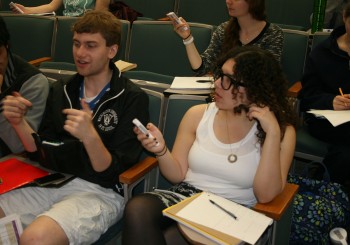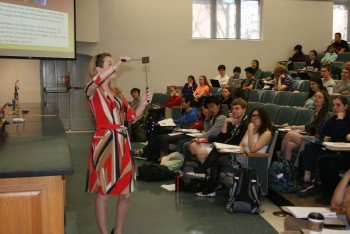When compared with traditional approaches, do active-learning pedagogies improve student attitudes and performance in learning knowledge and skills in introductory physics?
 The Active Physics project, a collaboration of CIRCLE and the Department of Physics, is an investigation into the differences between two calculus-based introductory physics courses at Washington University: a traditional lecture-based sequence (Physics 117/118) and a more student-centered, active-learning based sequence (Physics 197/198). The primary goals of the 197/198 “active physics” sequence, which has been offered since 2004, are to strengthen students’ conceptual reasoning, estimation, and approximation skills as well as to develop quantitative problem-solving skills.
The Active Physics project, a collaboration of CIRCLE and the Department of Physics, is an investigation into the differences between two calculus-based introductory physics courses at Washington University: a traditional lecture-based sequence (Physics 117/118) and a more student-centered, active-learning based sequence (Physics 197/198). The primary goals of the 197/198 “active physics” sequence, which has been offered since 2004, are to strengthen students’ conceptual reasoning, estimation, and approximation skills as well as to develop quantitative problem-solving skills.
Study Overview
The study seeks to better understand these two distinct learning environments and their relationships to improvements in students’ physics-related knowledge, skills, attitudes and beliefs about learning. This study also contributes to our understanding of the effect of active-learning methods on student performance in introductory science courses. What we learn can help Washington University faculty to improve their planning, implementation, and support of introductory physics and other large introductory science courses.
The results from this study may also contribute to a wider research base on the benefits of engaging students through student-centered, active-learning approaches as called for nationally by organizations including the National Academy of Sciences, the President’s Council of Advisors on Science and Technology, and the American Association for the Advancement of Science.
Study Results
 In 2014 we completed a three-year evaluation of Washington University’s active physics course. The results, which were published in the July 2, 2014 issue of Physical Review Special Topics – Physics Education Research, show that, with proper implementation, the benefits of active learning extend to large classes, where students learn as practitioners grappling with questions.
In 2014 we completed a three-year evaluation of Washington University’s active physics course. The results, which were published in the July 2, 2014 issue of Physical Review Special Topics – Physics Education Research, show that, with proper implementation, the benefits of active learning extend to large classes, where students learn as practitioners grappling with questions.
The study showed that the active physics course consistently outperformed traditional lecture courses in cultivating conceptual learning gains and expert-like attitudes towards physics. Results also showed that the active-learning approach, which opens up multiple avenues for in-class participation, slowed the attitudinal declines seen in traditional introductory physics courses. Given the historical underrepresentation of females in the STEM fields, it is notable this attitudinal support was equally helpful for female and male students.
When the active physics course began 10 years ago, only one section was available. Student demand since then has opened up five more sections of active physics, so that today there is only one section of the traditional lecture course. Given the success of its methods, instructors in the traditional physics sequence are also increasingly incorporating active-learning strategies.
Physics lecturer Mairin Hynes notes students’ deep engagement with the material in her active physics classroom:
“Students get really excited when we have questions that involve predicting the outcome of a demonstration and when they can actually see proof of whether or not they were correct, rather than just hearing an explanation with some equations.”
She cites another strength of the course’s focus on complex problem solving:
“It expands learning for everyone when we hear a student explain his/her answer to a question and the rationale behind the answer. I’m constantly amazed by how creative students can be in reasoning through a question in a way I never thought of or have heard before. It’s also exciting to hear how students see analogous situations in new and unexpected places.”
New Study Underway
Building upon this project, we are currently in the midst of a new study that focuses on improving student problem solving skills in Active Physics. The method was to give students the same three problems at the beginning of the semester, then again at the end of the semester in order to compare their performance after taking the traditional physics course or the active physics course. We are trying to determine if a certain instructional format promotes more improvement in complex problem solving skills. While there have been studies on attitudes towards learning in physics as well as on gains in conceptual knowledge, this is one of the first studies to look directly at problem solving in physics..
Publication
Cahill, M. J., Hynes, K. M., Trousil, R., Brooks, L. A., McDaniel, M. A., Repice, M., Zhao, J., Frey, R. F. (2014). Multiyear, multi-instructor evaluation of a large-class interactive-engagement curriculum. Physical Review Special Topics – Physics Education Research, 10(2).
Read the Record story on the active physics project.
Collaborators
Lisa Brooks (Physics)
Michael Cahill (CIRCLE)
Gina Frey (CIRCLE, Chemistry)
Mairin Hynes (Physics)
Mark McDaniel (CIRCLE, Psychological & Brain Sciences)
Michelle Repice (Teaching Center)
Rebecca Trousil (Physics)
Jiuqing Zhao (CIRCLE)
Funding
HHMI funding supported portions of the implementation and data collection for this project.